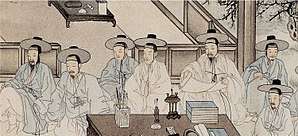Hanjeungmak
 |
| Part of a series on the |
| Culture of Korea |
|---|
| History |
|
Music and performing arts |
|
|
Monuments |
|
National symbols of Korea |
|
Hanjeungmak (Hangul: 한증막, Hanja: 汗蒸幕) is Korean traditional sauna. Intensely hot and dry, it uses traditionally burning wood of pine to heat a domelike kiln made of stone.
History
The first mention of hanjeungmak, initially referred to as Hanjeungso(Hangul: 한증소, Hanja: 汗蒸所), is found in the Annals of Sejong in the 15th century.[1][2] The record also states that the Korean kiln saunas were used for medicinal purposes. At that time, hanjeungmaks were state-supported kiln saunas maintained by Buddhist monks. Since 1429, the saunas were constructed separating facilities for men and women.[3] There are a picture painted by Kim Jun geun in the 19th century depicting a hanjeungmak and its circular wall made from bricks accompanied by a bath house.
Trends
Nowadays, hanjeungmaks are incorporated into Korean-style spa, jjimjilbang rather than an independent facility. Bulgama installed in jjimjilbang is a variety of hanjeungmak, heated with higher temperature. Sometimes the dome-shaped walls of kiln rooms are plastered with loam, salt, minerals.
See also
Notes
- ↑ 한영준. "조선보다 못한 '한증막 안전'". 세이프타임즈 (in Korean). Retrieved 25 March 2017.
- ↑ "Jjimjilbang: a microcosm of Korean leisure culture". The Korea Herald. 1 April 2010. Retrieved 25 March 2017.
- ↑ 김용만. "온천". 네이버캐스트 (in Korean). Retrieved 25 March 2017.
Further reading
- Stein, Carol. THE SECRET LA REVISTA. Han-Jeung-Mak